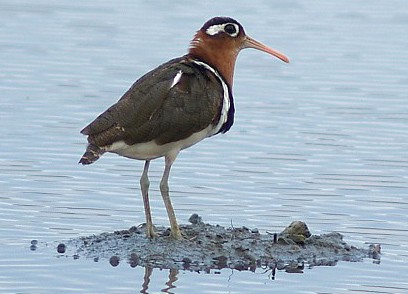Greater Painted-snipe
A species of Old World Painted-snipes Scientific name : Rostratula benghalensis Genus : Old World Painted-snipes
Greater Painted-snipe, A species of Old World Painted-snipes
Botanical name: Rostratula benghalensis
Genus: Old World Painted-snipes
Content
Description General Info
 Photo By User:Alnus , used under CC-BY-SA-3.0 /Cropped and compressed from original
Photo By User:Alnus , used under CC-BY-SA-3.0 /Cropped and compressed from original Description
Medium-sized, plump wading bird. Long reddish-brown bill, slightly decurved at tip, and distinct white or pinkish eye patch. Rounded, buff-spotted wings and short tail. White of breast extends up around top of folded wing. The painted-snipe is not related to the true snipes and differs from them in habits, flight and appearance, being far more colorful and having longer legs than the snipes. It is unusual in that the female is larger and more brightly colored than the male, with the sides of the head, neck and throat a rich chestnut brown, and a distinct black band across the breast; the male is paler and greyer. 
Size
28 cm
Colors
Brown
Black
Gray
White
Nest Placement
Ground
Feeding Habits
Greater Painted-snipe has a varied diet including insects, crustaceans, molluscs, and seeds. This species forages primarily by probing with its bill, displaying unique hunting techniques. Notable dietary adaptations ensure its success in diverse habitats.
Habitat
Greater Painted-snipe thrives in tropical and subtropical wetlands, typically up to 1800 meters elevation but can occur higher in some regions such as the Himalayas. Preferring recently flooded areas influenced by rainfall patterns, greater Painted-snipe occupies diverse wetland habitats including marshes, swamps, ponds, streams, reedbeds, rice fields, and even mangroves. Although more regularly found close to water sources, it occasionally frequents open grasslands near wetlands when foraging for food.
Dite type
Aquatic invertebrate eater
General Info
Feeding Habits
Bird food type
Behavior
Not a vocal species; the male at times utters a shrill trill, while the female makes a guttural ook sound as well as hissing noises during breeding displays. Usually found close to the fringes of reed beds along shorelines of marshes, swamps, ponds and streams. Solitary or in pairs, sometimes in groups of up to 12. Rather shy and retiring, skulking close to the vegetation so that it can retreat to cover if disturbed. When flushed, flies like a rail with legs dangling. Bobs hindquarters on landing and sometimes when walking. Probes for food in the mud. The female initiates courtship and may mate with more than one male. The male incubates the eggs and takes the parental care. 
Species Status
Not globally threatened.
Scientific Classification
Phylum
Chordates Class
Birds Order
Shorebirds Family
Painted-snipes Genus
Old World Painted-snipes Species
Greater Painted-snipe